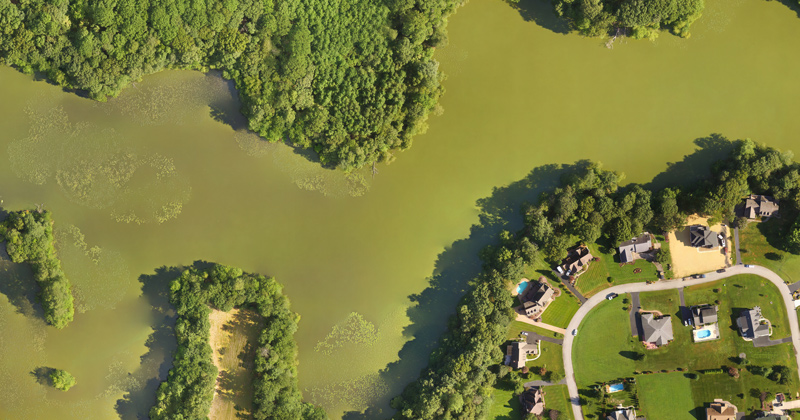


Quantifying global algal blooms
Photo by Stephanie Dohner July 03, 2023
UD’s Yun Li part of research group using satellite imagery to quantify and characterize global harmful algal blooms
Phytoplankton blooms — accumulations of microscopic algae in the surface of fresh and marine bodies of water — have complex and sometimes contradictory responses to the environments they are exposed to in coastal oceans.
On the one hand, they can be beneficial to coastal fisheries because they fix carbon at the base of the food chain, which helps support fisheries and ecosystems across the globe. On the other hand, when algae spread too rapidly, it can lead to harmful algal blooms (HABs). These HABs produce toxins that accumulate in the food web, causing closures of fisheries and illness or mortality to marine species and humans. They also deplete oxygen in bottom waters which can cause fish and invertebrates to die in large numbers, leading to serious consequences for coastal communities.
As a result of climate change, these overall algal blooms around the globe are estimated to become more frequent and more widely distributed.
To help quantify and provide a detailed characterization of bloom occurrence and distribution across the globe, an international group of researchers — including University of Delaware assistant professor Yun Li — recently used satellite observations to map daily coastal algal blooms between 2003-2020. The results were published in March 2023 in Nature.
Lian Feng, associate professor at the Southern University of Science and Technology in China, was the corresponding author on the paper.
Expanding and intensifying blooms
The researchers found that algal blooms occurred in 126 out of the 153 coastal countries examined and that on a global scale, both the frequency and spatial extent of the blooms increased significantly over the study period of 2003-2020. However, they also found that the blooms weakened in tropical and subtropical areas of the Northern Hemisphere which is where Li helped to bring her expertise to the project.
Li, assistant professor in the School of Marine Science and Policy, said that while most areas of the globe have bloom-favorable seasons when the surface temperature of the water rises, it is not always the case with the tropical and subtropical areas. The researchers found that the sea surface temperature-based mechanism they used for other areas to measure bloom frequency does not fully apply to the tropical and subtropical regions.
“The other researchers talked with me after the initial analysis was done for the quantification because they found that there are some regions that show a decrease in temperature but an increase in the algal blooms which is counterintuitive,” said Li. “They had different dynamics that were under consideration but they were still missing certain dynamics to explain the blooms in the western boundary current regions.”
In a 2022 paper published in the Journal of Geophysical Research: Oceans on which she was a co-author, Li and the corresponding author Xinfeng Liang, associate professor in UD’s School of Marine Science and Policy, wrote that western boundary currents — especially those in the tropical and subtropical regions — are able to lift water mass vertically in the water column, resulting in upwelling that contributes significantly to the vertical transport of ocean properties and materials such as heat and nutrients.
When the researchers for this paper applied the upwelling data that Li had analyzed, they found a high consistency with their satellite imagery and realized that it provided a regional explanation for why the algal blooms were weakened in certain tropical and subtropical areas of the Northern Hemisphere.
The research team used their own algorithm to detect the level of phytoplankton blooms in coastal oceans. Li said this can be a challenge because there is a lot of contamination of satellite signals when it comes to the coastal regions so even before they had any results, creating this high-resolution algorithm was incredibly impressive.
“Their algorithm detects blooms within one-kilometer resolution which is really high,” said Li. “For reference, the widely-used product is about 4-kilometer resolution, so they are really pushing the limit with one-kilometer resolution.”
Phytoplankton bloom implications
Li said the paper can be used as a tool for policy makers to evaluate decisions according to new information as it provides a map showing where blooms are occurring, when they will occur and how they are evolving with climate change.
“This is the base of the food web so we think that this can be used as input data for most food web models or fishery management information,” said Li, who noted that some areas in the United States already have applications of when the fishing season opens or closes with the consideration of potential changes in phytoplankton blooms.
By using this data, an area like the high latitudinal regions would be able to know that they might need to have their fishing season occur earlier in the year, as the warmer weather would lead to an earlier bloom.
In addition, the information can be used to know when to close up conservation areas in order to protect the ecology in those areas.
“This will provide guidance for the policymakers or stakeholders to guide the market price and for other human activity to be able to handle those earlier harvests,” said Li.
Contact Us
Have a UDaily story idea?
Contact us at ocm@udel.edu
Members of the press
Contact us at 302-831-NEWS or visit the Media Relations website

